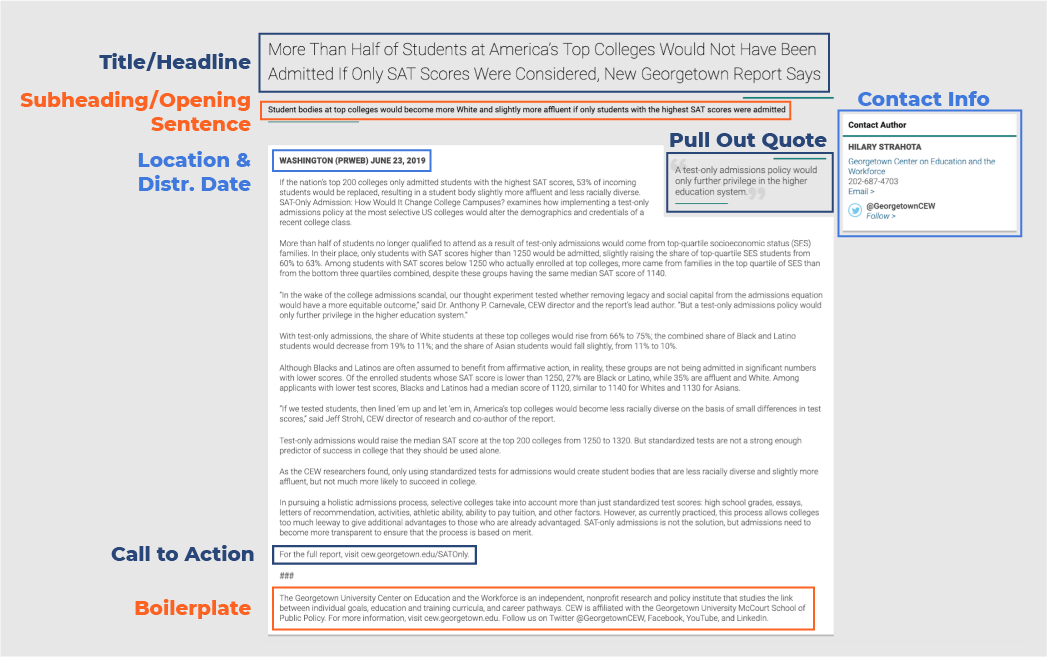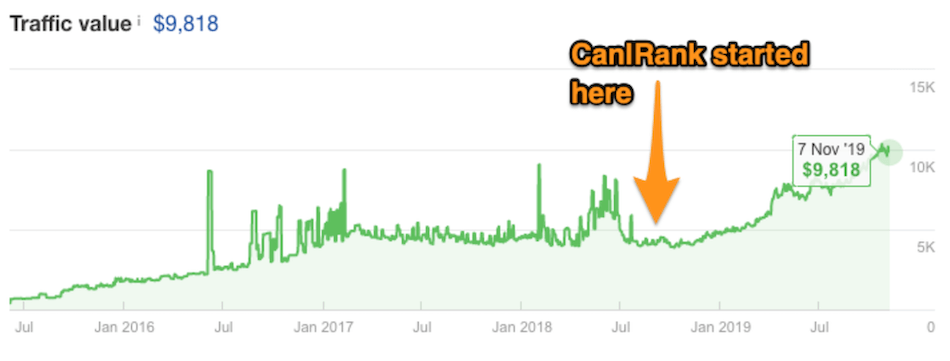In an era where marketing professionals and PR specialists are increasingly expected to maximize the impact of every minute of their time, the benefits of a multi-purpose SEO press release are myriad. While press releases and SEO might seem like they’re at odds with each other, when executed well, the goals of each can be furthered. When writing an SEO press release, you’ll want to consider two factors above all else- viral potential and reputation-building.
Both approaches demand relationship building:
- Ranking in organic search involves developing relationships with other website owners to earn backlinks.
- Landing your story in reputable publications means pitching busy journalists.
Outreach is time consuming and requires knowledge of the influencer landscape, so many businesses turn to outside experts. The right agency can get a brand new company competing with established players in a matter of months. Sadly, the typical experience of small businesses with SEO and PR agencies is not a positive one.
Unfortunately, many SEOs practice reckless, black hat techniques that cause more harm than good in the long run. Traditional PRs deliver a trickle of small wins with the promise of eventual ROI. Is there an alternative?
Enter the SEO press release: an economical tool for reaching journalists. SEOs use them to build links, without understanding readers. PRs, meanwhile, tend to focus on soft brand metrics, but lack the technical knowledge to optimize for search. Writing press releases for SEO is a delicate balance- Smart strategies prioritize the quantifiable impact of earning links, and treats publicity as added value.
This article will cover:
- When to write a press release
- What journalists want to see
- How to maximize its SEO value
- Which distribution services to use
- Where to send your story when the press won’t bite
1. When to write a press release
 Journalists receive hundreds of pitches daily. Part of the job is filtering the ordinary from the spectacular. Events that seem vital from the inside are often relegated to the junk pile once they arrive on the news desk.
Journalists receive hundreds of pitches daily. Part of the job is filtering the ordinary from the spectacular. Events that seem vital from the inside are often relegated to the junk pile once they arrive on the news desk.
Another common question is, “are press releases still relevant?” Yes! Press releases are appropriate for historical moments – like a product launch, especially if it pushes technological boundaries. Expansions, partnerships and funding rounds are also relevant to the business press.

Show data that can be translated into another industry to create branded anchors in a new niche. We’re halfway through the football season and using press releases to show how a collision between two football players creates the same impact force of dropping a cinder block from 200 feet. We’re also reaching out to automotive publications providing them an opportunity to interview a retired pro-NFL.
Joe Babi
Founder
Joseph Paul Digital Agency
Journalism is increasingly data-driven. Today, stories break first on social media, so professionals must instead compete on precision and depth – making exclusive information essential. Whether it comes from operational, product or user behaviour data, your original research is irresistible to the press. Releases titled ‘report’ or ‘new study’ are orders of magnitude more appealing than opinions.
New hires aren’t newsworthy unless they’re well-known. Routine product updates and self-promotion are likely to be seen as a nuisance. Above all, make sure your story hasn’t been told 1,000 times before.
2. Structure & Boilerplate: Making journalists’ lives easier
 Include all the functional elements journalists need to get to work, or risk driving them away before they get past the first line.
Include all the functional elements journalists need to get to work, or risk driving them away before they get past the first line.
Here’s the structure a journalist wants to see:
Your title should be perfectly viable as an article headline. The subheading should offer context, letting journalists quickly gauge if the story is relevant. This is followed by the traditional distribution line, including the date and location, before the body of the release. Include a quote – some distribution services will even allow you to format it as a pullout.

The key is to make it a win-win situation for both the publication and your business. Tailor your releases to fit their format so the editor can copy and paste the release directly into their system
Marine Klein
Head of Digital
Commusoft
Hopefully your reader is ready to learn more. Include contact details, and a standardized boilerplate at the bottom – one or two up-to-date sentences about the company. Include your tagline if you have one, and highlight something attention grabbing about the company. This is your chance to mention your three million users, being voted best workplace or previous feature on CNBC. Your goal is to establish credibility – so keep it factual, and free of exaggerations.
Avoid jargon if possible, but consider including industry keywords. A journalist might use part of your boilerplate to introduce your company, but if not you can at least win some search relevancy by being cited in context.

Use keywords in your press releases the same way you would in web content or a blog: avoid overstuffing, work them in naturally, and use tools like Moz to find popular keywords and their alternatives.
Keri Lindenmuth
Marketing Manager
KDG
Modern, digital press releases can also include CTAs. A link to share on social media, or go to your homepage for more information, can encourage positive engagement. By including custom short URLs in your press releases in place of generic short links (like butt.ly/83r8h), you’ll encourage engagement by having memorable links like YourBrand.rocks/PressKit or YourBrand.social/LinkedIn, and you’ll also be able to monitor the levels of interaction with your links using click tracking. These branded URLs can easily be created and managed using a link management platform like Rebrandly URL Shortener.
Case Study
Fieldwire
Fieldwire is a platform that helps construction businesses manage worksites. When the team secured a partnership with a well-known company in the industry, they saw a valuable press opportunity. Journalists in the space were keen for news about this particular construction firm, and CanIRank worked to leverage this excitement to win coverage for Fieldwire.
One of the most important elements of the press release was a well crafted boilerplate that captured the essence of Fieldwire, including keywords that allowed journalists to quickly understand the company. This allowed the rest of the release to utilize the name recognition of the partner, highlighting the facts with quotes from both companies about what working together would help each of them achieve.
By giving journalists information about a story they already wanted to tell, this press release garnered the attention of many high-profile industry outlets, introducing them to a new angle and explaining the importance of Fieldwire. The result was coverage in important publications like Construction Executive, ForConstructionPros.com and MPAQ, not to mention foreign press in markets that Fieldwire was looking to enter.
3. The headline and the subheading: your one chance to get their attention

Truth be told, all the SEO tactics in the world won’t help your press release if it’s missing one crucial element: a killer headline. Studies have found that the majority of people share/engage with content based on the headline alone. Consider using numbers, if applicable (e.g. a percentage)
Jaykishan Panchal
SEO & Content Marketing Manager
E2M Solutions Inc.
 The title is the most important component of your press release. Journalists are starved for time; they need to scan hundreds of headlines at blistering speed. Yours must be unique and informative.
The title is the most important component of your press release. Journalists are starved for time; they need to scan hundreds of headlines at blistering speed. Yours must be unique and informative.
Consider writing the body before you decide on the title. The hook often reveals itself only when the facts are on the page. The best pitches are those that can be quickly spun into articles; if your title is also a great news headline, the journey is that much shorter. Consider using Coschedule’s headline analyzer to gauge the potency of your hook.
Titles should use ‘headline case.’ There’s no universal standard, but AP style is straightforward: capitalize the first letter of each word, except for short prepositions (on, off, in, at, by), coordinating conjunctions (for, and, not, but, or, yet, so) and articles (a, the). Capitalize the first and final words regardless. Here’s a free online tool for formatting titles into AP style if you need help.
Some examples:
An unsalvageable headline:
Business Leaders Identify Print as a Key Strategic Asset for Growth and Innovation
An unconvincing claim, too long, and we have no indication about the identity of the business leaders.
A mediocre one with redeeming features:
Cision Acquires TrendKite, Extending its Leadership in Measurement and Attribution
Too long and doesn’t hit the key points. “Extending its Leadership” is self-aggrandizing. Something like “Bringing Impactful AI to PR Pros” would evoke more feeling.
And a strong headline:
United Airlines Wants to Fuel Jets with Your Leftover Dinner
Titles like these provide the ‘who’ and the ‘what’ – leaving reader asking ‘how?’
You’ve captured imaginations. Now offer context. You’re asking a journalist to pause their scanning and focus on the content of your release. Your subheading must make the case for why.
If your company isn’t named in the headline, include it in your subhead, along with any other big players as long as they don’t steal the spotlight. Aim for 20-25 words, and use regular sentence case.
Identify the keywords you’d like to rank for. You’re aiming to influence Google (PR indexes are probably still crawled for relevancy, even though the search engine has emphatically stated it ignores links) and the journalist, so include your primary keyword early.
Case Study
Keyword Research
When working on press release optimization, it’s not always obvious which keywords represent the strongest opportunities for ROI.
For example, one company was keen to rank for terms like ‘marketing reporting stack’ – as that was central to their positioning. However, CanIRank’s software identified that this would not bring in useful amounts of traffic, even if the site ranked number one. CanIRank’s team of experts dug into the data and discovered that queries like ‘data aggregation’, ‘Google Data Studio’, ‘UTM’ and ‘marketing dashboard’ offered bigger opportunities. By optimizing for these keywords, not only on-page but also by using them prominently in press release headlines and subheads, they were able to rank, bringing qualified visitors to the site.
4. The Body of an SEO Press Release: Who, What, When, Where, Why
 Now add the emotion. Elaborate on your hook without repeating the headings, and cover the ‘five W’s – Who, What, When, Where and Why: these are the critical components journalists need. Your first paragraph should achieve all of this, and be the strongest content in the release.
Now add the emotion. Elaborate on your hook without repeating the headings, and cover the ‘five W’s – Who, What, When, Where and Why: these are the critical components journalists need. Your first paragraph should achieve all of this, and be the strongest content in the release.
A quote is your best opportunity to editorialize the news. If it’s compelling, it could be included unedited.

Craft your news releases to read more like a CNBC story, and not like a QVC selling segment. Most importantly, avoid presenting your news with breathless hype – especially hyperbolic assertions with lots of gratuitous exclamation points – that will prevent you from being taken seriously by journalists and editors.
Rafe Gomez
Co-owner
VC Inc. Marketing
For the remaining paragraphs, provide supporting information as an inverted pyramid – dryest details last.
Shorter press releases tend to perform better, so be concise. That’s easier with a digital approach. Modern newswires allow links in the body of releases, which means you can move less essential information to your website. Journalists can then explore at leisure, making it easier to plan their story.
Historically, SEOs stuffed links into press releases to score easy authority from indexes. Google no longer tolerates this practice, and today it can seriously damage your trust signals. Adding the HTML attribute rel=”nofollow” to press release links clarifies your intentions (most press release distribution services now do this automatically) – and Google says these links still have some SEO value.
Case Study: SEO SAAS
Juicer
Any PR agency get coverage when a company already has news, but CanIRank actively works to create news by producing data-driven content that journalists crave.
Juicer is a SaaS product utilizing a low-touch sales model that relies on organic traffic. When CanIRank and Juicer started working together, there was little supporting content on the site, so CanIRank’s writing team produced high quality blog posts on a regular cadence. This content forms the backbone of the company’s promotion strategy, and since the start of the project, Juicer’s organic traffic has increased by 66%, it’s value more than doubling from $4,000 to $10,000 per month.
5. Press Release Distribution: Getting out onto the wires
 If you have media relationships, email them directly with any news.
If you have media relationships, email them directly with any news.

Maintain a database of contacts to which you can submit press releases directly (instead of simply using a newswire service). By cultivating personal relationships with these contacts, you can build more strategic backlinks featuring your preferred anchor text and url
Katie Weedman
Content Strategist
THAT Agency
To reach the wider community, use a distribution network – each have their own submission processes. The jury is out on the best day and time to send – but everyone agrees Fridays are bad, and weekends are worse. Instead of sending it at the top of the hour, try something like 10:22 am so you’re not competing with so many other releases.
Host a user friendly version of the release on your blog or press section. It shouldn’t be a duplicate, but an informal introduction to the news. Link to it prominently in the release.
CanIRank works with four distribution partners, each appropriate for different objectives and budgets. Here’s a breakdown of some of the top press release sites:
-
- BuzzBuilder $299 — 400 words, 1 target list, reposted on 60 sites, National Distribution, Distribution report, AP Newswire and Google News, 100,000+ Journalists
- NewsMaker $399 — 500 words, 2 target lists, repost to 90 sites, National Distribution, Distribution report, AP Newswire and Google News, 100,000+ Journalists
- PR Pro $499 — – 600 words, 3 target lists, repost to 120 sites, National Distribution, Distribution report, AP Newswire and Google News, 100,000+ Journalists
-
- Premium Plus $359 — 1 target list, additional costs for additional services, publishes on major news sites like Yahoo! News, BizJournals, and some TV networks
-
- Standard $189, Advanced $289, Premium $399 — No word limit, 50 – 150 reposts, no industry targeting on standard plan, premium plan includes distribution to journalists and bloggers, editorial process can be cumbersome and long
-
- Premium $69, Premium Pro $129, Premium Concierge $299 — No word limit, Basic distribution to 500-1,200 outlets, 250 – 400 reposts, doesn’t hit all the major networks of some other release options, journalist outreach is DIY. Quick distribution!
Keep in mind that you cannot simply buy coverage. Spamming the wires will earn you a poor reputation, or even get you blacklisted.

The key is to spend time researching a handful of highly targeted journalists to submit your press release to. If you don’t have the brand recognition of a large multinational, adopting a “hit and hope” strategy and submitting a press release to the well known networks is simply not going to work unless you have a totally unforgettable hook.
Nathan Thompson
Digital Marketing
Pavilion Broadway
Press releases are only hosted by aggregators for a certain period. To retain your backlink profile, publish and circulate your latest news at least once a quarter. Consider the value of getting journalists onto your site and increasing their awareness. Target intelligently, and cultivate mutually beneficial relationships. They’ll think of you when they need an expert source.

When making a list of media contacts, don’t forget to include local university papers! These papers often cover softer news and sometimes live on a .edu domain.
Claire Shaner
Product Marketing Manager
ZooWho
Summing up
Search engine optimized press releases are very possible, and journalists can be some of your most important advocates. They lend your brand not just real-world influence, but also digital authority. But while huge enterprises can absorb the uncertainty in anticipation of eventual success, that’s rarely an option for small, fast-moving operations.
SEO press releases can keep the door open to opportunities, but cannot substitute for a strong link building strategy. Understanding when to use them and how to get them right is crucial.

Outline a list of terms and conditions or further information about the release on your site which you know will need to be included in the article but that they won’t want to write out in full. It’s sneaky, but the SEO benefits are huge!
Louis Watton
Marketing Executive
Shiply
Journalists are bombarded with amateur pitches, while PR experts tend to build their networks at great expense and are unable to offer small businesses measurable ROI. Backlinks have quantifiable value due to the organic traffic they generate as part of an SEO strategy. For all but the largest organizations this is much more powerful than focussing on glamorous publications and spending precious time trying to shape the narrative.
Following this advice will maximize your chances of getting SEO value out of press releases. If you’re looking for a team of experts on demand to manage this process, CanIRank Full Service could be for you. Take a look at our case studies to learn more, or schedule a consultation to start the discussion about your outreach strategy right away.








Leave A Comment